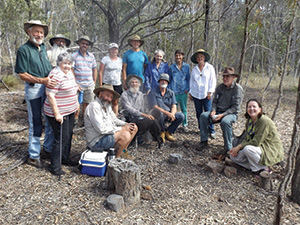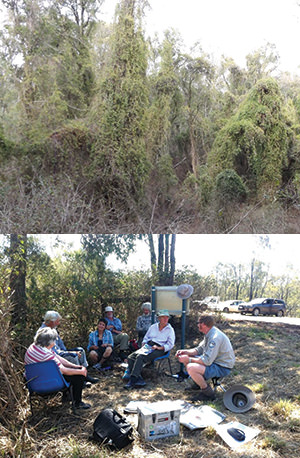
In 2015, a small group of landholders in the western Lockyer met to discuss their concerns about the condition of their local conservation park, Dwyers Scrub. The park protects a wonderful patch of semi-evergreen vine thicket that was being overtaken by weeds, namely Cat’s Claw Creeper and Madeira Vine. Turning their concerns into action, the Friends of Dwyers Scrub (FoDS) group sought registration as Queensland Parks and Wildlife Service (QPWS) volunteers and embarked on a monthly weeding program.
Almost from the outset of this work, it became clear to the group that the health of Dwyers Scrub and its capacity to provide habitats for native wildlife was largely dependent on the health of habitats in the surrounding landscape. If we were going to succeed in protecting the park’s biodiversity, we needed to involve more surrounding landholders in conserving and connecting patches of native vegetation.
Reflecting this broader agenda, FoDS became Lockyer Uplands Catchments Inc (LUCI) in 2016. The group embarked on a journey to raise awareness of connectivity conservation by engaging more landholders and supporters to improve and protect native vegetation and wildlife habitats on local properties.
LUCI currently has 43 members, most of whom are landholders with properties located in the Main Range to Helidon Hills regional biodiversity corridor. Together, LUCI members are working on conservation activities covering just over 3,000 ha of private land and 259 ha of protected parks.

While the monthly weeding program in Dwyers Scrub is a continuing labour of love for the original group of volunteers, LUCI now engages with its members and the wider community through a range of other activities.
The group is very proud of its ongoing citizen science project on Glossy Black-Cockatoos (GBCs), which commenced in 2016 under the mentorship of Dr Guy Castley of Griffith University. The project involves eight properties in the long-term monitoring of the presence of the GBC in the landscape and an investigation of GBC feed tree flowering, pollinating and fruiting cycles. The project is supported by Lockyer Valley Regional Council and will inform LUCI’s GBC habitat conservation measures and add to the understanding of the species. The GBC along with the Koala and Black-breasted Button-quail, all present in the LUCI landscape, are the three marker species LUCI has adopted for prioritising its habitat conservation and monitoring activities.
Since mid-2018, some LUCI members have met quarterly as a Biodiversity Property Planning group, to share and learn from each other’s approach to managing and improving the biodiversity on their property. In addition to peer support, each meeting also includes an educational component on a particular topic.
Our autumn and spring Special Interest Walks on members’ properties are proving popular with each walk an educational experience in local flora and fauna and ecosystems and an opportunity to connect with members, neighbours and supporters. LUCI’s annual breakfast is also a popular event regularly attracting around 50 people, with guest speakers talking on diverse topics including the value of insects, feral animal management and technology for assessing biocondition.
LUCI has a strong connection to the Land for Wildlife program. A number of LUCI’s members are also Land for Wildlife members and LUCI provides an extra layer of connection for those members. LUCI’s work is enriched by the involvement of the Lockyer’s Land for Wildlife Officer, Martin Bennett. Well known for his amazing knowledge of native flora and ecosystems, Martin is a willing expert/participant on our Special Interest Walks, a mentor with our Property Planning Group and a point of referral for any of our questions about Regional Ecosystems and flora identification.
LUCI’s overall goal is to improve the health of native habitat on private and public land in our local landscape and to better connect these patches to facilitate movement of wildlife and safeguard genetic diversity. LUCI’s vision is to see a connected landscape from Main Range to Helidon Hills.
LUCI hopes to undertake more biodiversity surveying of flora, fauna and fungi in order to build a picture of the ecological values of our local landscape. This will require expert assistance and LUCI is always on the lookout for people willing to provide expert knowledge and field skills. Meanwhile, on-ground, LUCI will continue to support members in conservation activities on their properties and, ideally, engage with more landholders, including Land for Wildlife members, in biodiversity property planning events and peer support activities.
To find out more about LUCI, visit www.lockyeruplandscatchmentsinc.wordpress.com or email lucatchmentsinc@gmail.com
Article by
Diane Guthrie
Land for Wildlife member
East Egypt, Lockyer Valley
and President of LUCI
